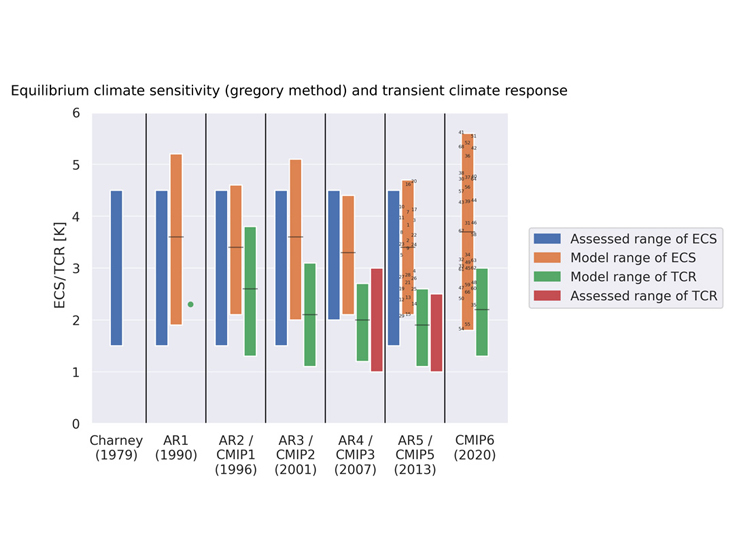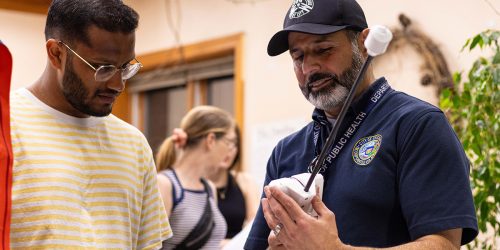NOAA’s Modeling, Analysis, Predictions, and Projections (MAPP) program is announcing seven new three-year projects starting in Fiscal Year 2020 (FY20) that aim to examine a key parameter of the climate system — climate sensitivity (the amount of future warming) — in climate and Earth system models. The competitively selected projects total $3,990,176, including $3,960,176 in grants and $30,000 in other awards.

The response of Earth’s climate to projected increases in the concentrations of energy-trapping atmospheric greenhouse gases (GHGs) is immediately evident in global temperature increases. Because the amount of future warming, or climate sensitivity, is a critical factor affecting climate projections (e.g. precipitation, extremes, sea level, sea ice, etc.) around the world, scientists need to reduce uncertainty in climate model sensitivity estimates.
These model uncertainties largely arise from how clouds, interactions with aerosols, and other processes which may amplify or diminish the impact of increasing GHGs will change in response to warmer conditions and, combined with ocean heat uptake processes and feedbacks, will contribute to climate sensitivity.
To help reduce overall uncertainties in future climate projections, the MAPP Program solicited research investigations to constrain climate model sensitivity focusing on clouds, convection, and aerosol processes and their role within the Earth system. A Task Force formed of the funded investigators will be led by Brian Soden (U Miami), Brian Medeiros (NCAR), and Ming Zhao (NOAA GFDL). The Task Force will focus on creating collaborations between the projects and extracting collective lessons from the research. Ultimately, the new funded projects will enable improved understanding of the sources of uncertainty in climate sensitivity, promote methods to constrain that uncertainty, and develop evaluation metrics to help improve climate and Earth-system models.
The seven new projects are:
- Linkage between deep convection, large-scale circulation and low cloud feedback
This project aims to establish the physical processes that link deep convection, the Hadley Circulation and low cloud feedback; develop process-oriented model diagnostics to characterize CMIP6 model representation of these pathways; and apply multiple observations to constrain these pathways so as to constrain equilibrium climate sensitivity. This project will leverage the process-oriented diagnostics approach and framework in the MAPP Model Diagnostics Task Force (MDTF) and contribute new diagnostics to augment the existing software package, helping to accelerate model improvements and reduce the uncertainties in climate projections.- PI: Hui Su, UCLA
- Co-PI: David Neelin, UCLA
- Unfunded Collaborators: Jonathan H. Jiang UCLA; Kevin Bowman UCLA; Leo J. Donner GFDL
- Investigating sea-surface temperature pattern controls on cloud feedbacks in CMIP6 coupled models
This project aims to better understand the contributions of regional biases in both climatological sea-surface temperature (SST) and patterns of SST change from CMIP6 on their projections of cloud feedback through an analysis of CMIP6 and CFMIP v3 simulations, and a series of coordinated modeling experiments designed to fill gaps in the CFMIP v3 framework.- PI: Gabriel Vecchi, Princeton University
- Co-PI: Brian Soden, University of Miami
- Using unforced variability of low cloud ‘hot-spots’ to develop better constraints on Earth’s climate sensitivity
This project aims to further refine our understanding of the link between low clouds and Earth’s climate sensitivity, and to develop potential constraints on the behavior of low clouds with warming. Researchers will study the unforced variability of low-level clouds and their governing meteorological conditions over the global ocean in order to identify specific geographic regions (“hot-spots”) in which the variability of low cloudiness is especially indicative of models’ response to warming.- PIs: Nicholas Lutsko, Scripps Institute Institution of Oceanography; Joel Norris University of California San Diego
- Co-PIs: Ming Zhao NOAA GFDL (Princeton, NJ, 08540); David Paynter NOAA GFDL
- Constraining and understanding climate sensitivity with process-oriented diagnostics
The project is a holistic, bottom-up approach to understanding climate sensitivity focusing on cloud processes. The project will especially focus on understanding the high climate sensitivity of the Community Earth System Model, version 2 (CESM2).- PI: Brian Medeiros, National Center for Atmospheric Research
- Co-PI: Andrew Gettelman, National Center for Atmospheric Research
- Evaluating and constraining models’ stratocumulus and cumulus cloud feedbacks in the tropics using satellite observations to reduce uncertainties in future climate projections
In this project, researchers will use a new observational constraint derived from CloudSat-Cloud-Aerosols Lidar and Infrared Pathfinder Satellite Observations (CALIPSO) observations, which discriminate stratocumulus from cumulus clouds, in concert with three different methods to separate stratocumulus- from cumulus-dominated regimes. The two main outcomes of the project are to reduce the uncertainty in models’ equilibrium climate sensitivity due to low-cloud feedback contributions and to propose new guidance for model development in specific parametrizations (turbulence and convection).- PI: Gregory Cesana, Center for Climate Systems Research Columbia University
- Co-PI: Robert Pincus, Lamont-Doherty Earth Observatory Columbia University
- Unfunded Collaborator: Andrew Ackerman, NASA Goddard Institute for Space Studies
- Process-level metrics for evaluating the realism of CMIP6 models’ climate sensitivity based on multiple lines of observational evidence
This project will develop evaluation metrics (diagnostics) of the radiative feedbacks in CMIP6 models contributing to equilibrium climate sensitivity (ECS). This project will also evaluate the ability of the observable metrics to constrain ECS and future warming and then devise approaches for constraining models’ ECS using multiple key observational metrics.- PI: Kyle C. Armour, University of Washington
- Co-PIs: Aaron Donohoe University of Washington; Cristian Proistosescu University of Illinois Urbana-Champaign
- Unfunded Collaborators: Daniel Amrhein NCAR; Yi Ming GFDL; Mark Zelinka Lawrence Livermore National Laboratory
- Understanding bulk surface flux algorithm contributions to climate projection uncertainties
This project will investigate surface flux feedbacks in observations, and leverage the COARE3.5 bulk flux algorithm to assess biases in surface fluxes and their feedbacks for models participating in CMIP6.- PI: Charlotte DeMott, Colorado State University
- Co-PI: Carol Anne Clayson, Woods Hole Oceanographic Institution





